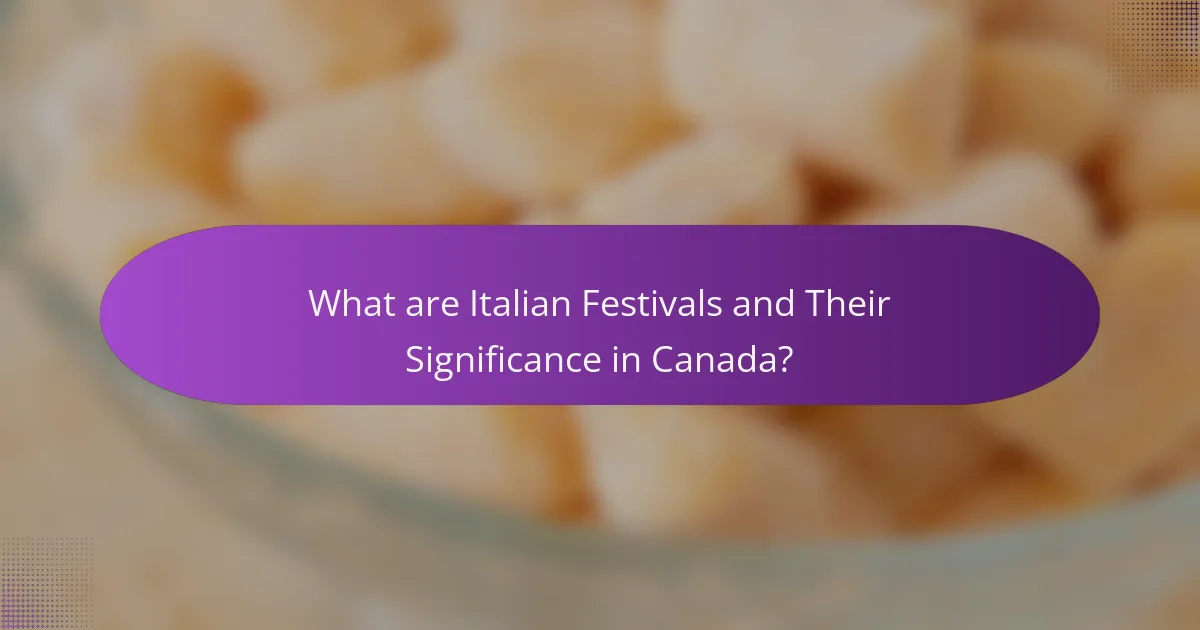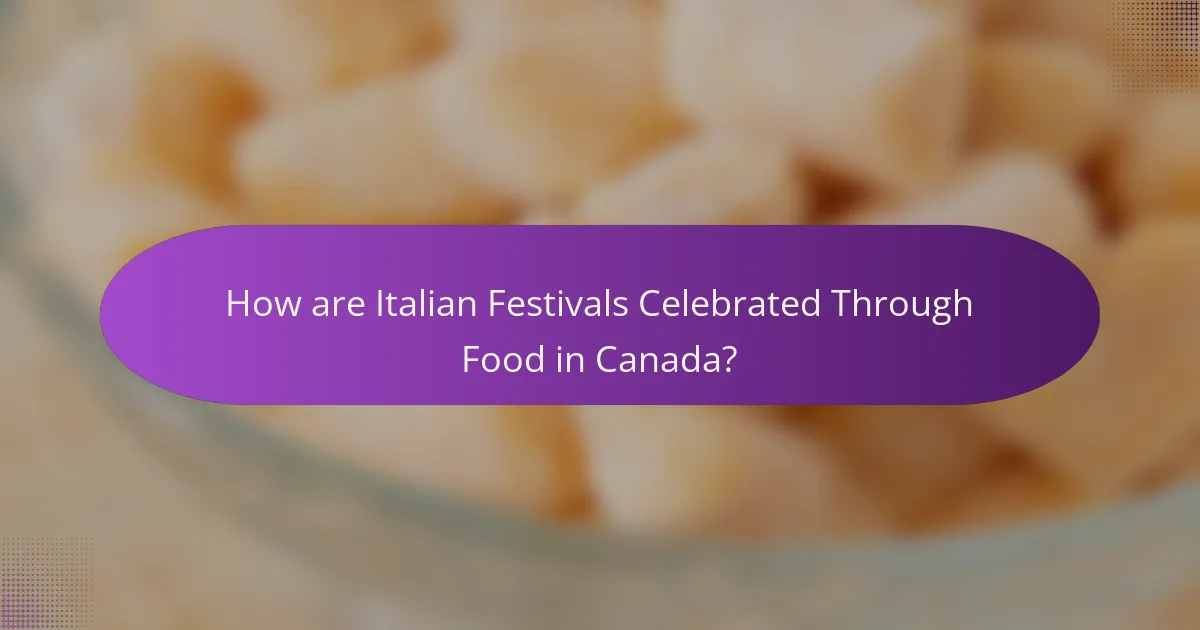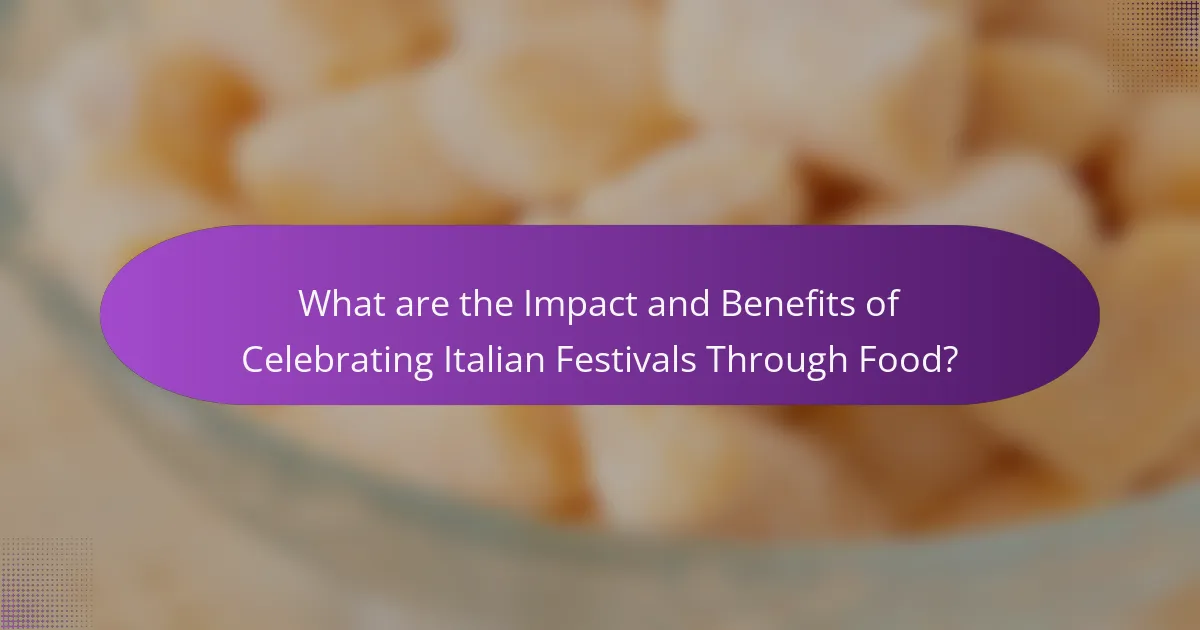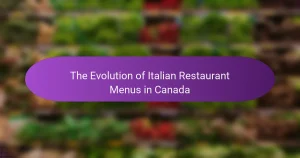
What are Italian Festivals and Their Significance in Canada?
Italian festivals in Canada celebrate the rich cultural heritage of Italian immigrants. These festivals often feature traditional music, dance, and, notably, food. They serve as a platform for community bonding and cultural exchange. Events like the Taste of Little Italy in Toronto highlight Italian cuisine and local businesses. Festivals also promote understanding of Italian traditions among diverse populations. They contribute to the economy through tourism and local commerce. The significance of these festivals lies in preserving Italian identity and fostering multiculturalism in Canada. In 2021, over 1.6 million Canadians identified as having Italian ancestry, showcasing the importance of these celebrations.
How do Italian festivals reflect cultural heritage?
Italian festivals reflect cultural heritage through traditional practices, foods, and communal activities. These festivals celebrate historical events, religious traditions, and regional customs. For example, the Feast of San Gennaro honors the patron saint of Naples with processions and food stalls. Such events showcase regional dishes like arancini and cannoli, linking culinary practices to cultural identity. Festivals also foster community bonding, as families and friends gather to celebrate shared traditions. Furthermore, they preserve language, music, and art forms unique to Italian culture. The vibrant displays of costumes and performances highlight the rich history of various Italian regions. Overall, Italian festivals serve as living expressions of cultural heritage, maintaining connections to the past while evolving in contemporary contexts.
What historical events led to the establishment of these festivals?
Italian festivals in Canada were established due to significant waves of Italian immigration. These waves began in the late 19th and early 20th centuries. Many Italians sought better economic opportunities and fled political unrest in their homeland. They brought their cultural traditions, including festivals, to their new communities.
The first major Italian festival in Canada was the Feast of St. Anthony in 1900, celebrated in Toronto. This event commemorated the patron saint of Padua and served to unite the Italian community. Over time, other festivals emerged, such as the Caribana and the Italian Week in Montreal. These festivals celebrate Italian heritage and foster community spirit.
The establishment of these festivals reflects the integration of Italian culture into Canadian society. They serve as a means to preserve traditions and share them with future generations.
How do these festivals promote community engagement?
Italian festivals in Canada promote community engagement by bringing people together through shared cultural experiences. These festivals often feature traditional food, music, and dance, fostering a sense of belonging. They encourage participation from local residents, creating opportunities for social interaction. Community members collaborate in organizing events, strengthening local ties. Festivals also support local businesses by showcasing their products and services. According to a study by the Canadian Council for the Arts, cultural festivals enhance community cohesion and pride. This involvement not only celebrates heritage but also builds lasting relationships among diverse groups.
Why is food a central element in Italian festivals?
Food is a central element in Italian festivals due to its cultural significance and communal nature. Italian festivals often celebrate regional traditions and family heritage. Food acts as a medium for sharing these traditions with the community. Dishes served during these festivals often have historical roots and recipes passed down through generations. Festivals feature local ingredients, showcasing the region’s agricultural bounty. This connection to the land enhances the authenticity of the culinary experience. Additionally, food fosters social interaction and strengthens community bonds among attendees. Celebrating together over meals creates a sense of belonging and shared identity.
What traditional dishes are commonly served during these celebrations?
Traditional dishes commonly served during Italian festivals in Canada include lasagna, risotto, and arancini. Lasagna is a layered pasta dish often filled with cheese and meat. Risotto is a creamy rice dish cooked slowly with broth and flavored with various ingredients. Arancini are fried rice balls typically stuffed with cheese or meat. Other popular dishes include cannoli, a sweet pastry filled with ricotta cheese, and pasta e fagioli, a bean and pasta soup. These dishes reflect the rich culinary heritage of Italy and are enjoyed during celebrations.
How do regional variations in Italian cuisine influence festival menus?
Regional variations in Italian cuisine significantly influence festival menus. Each region of Italy has distinct culinary traditions and local ingredients. For example, northern regions often feature polenta and risotto, while southern regions emphasize pasta and seafood. Festivals celebrate these regional specialties, showcasing local flavors and dishes. In Canada, Italian festivals often reflect these regional differences. For instance, a festival celebrating Sicilian heritage may include arancini and cannoli. Conversely, a festival focused on Lombardy might highlight ossobuco and panettone. This diversity enriches the culinary experience at festivals, allowing attendees to explore various Italian flavors.

How are Italian Festivals Celebrated Through Food in Canada?
Italian festivals in Canada are celebrated through a rich variety of traditional foods. Events often feature dishes like pasta, pizza, and cannoli, which reflect authentic Italian cuisine. Community gatherings, such as the Taste of Little Italy in Toronto, showcase these foods prominently. Local restaurants and vendors participate by offering regional specialties. Festivals also include cooking demonstrations that educate attendees about Italian culinary traditions. Food plays a central role in fostering community spirit and cultural pride during these celebrations. Many festivals highlight the importance of family recipes passed down through generations. This connection to heritage is a key aspect of the celebrations.
What types of food are featured at Italian festivals in Canada?
Italian festivals in Canada feature a variety of traditional foods. Common dishes include pasta, pizza, and risotto. Sausages and cured meats are also popular. Desserts like cannoli and tiramisu are frequently served. Fresh bread and focaccia are staple items. Many festivals showcase regional specialties from Italy. These foods reflect the heritage and culture of Italian Canadians. Festivals often include food vendors and cooking demonstrations.
How are these dishes prepared and presented at the festivals?
Dishes at Italian festivals in Canada are typically prepared using traditional recipes. Ingredients are often sourced locally to maintain authenticity. Cooking methods include grilling, frying, and baking, depending on the dish. Presentation is visually appealing, often featuring colorful garnishes and rustic serving ware. Many dishes are served in large portions for sharing, promoting a communal dining experience. Vendors frequently showcase their offerings in vibrant stalls or food trucks. This setup enhances the festive atmosphere and attracts attendees. Overall, the preparation and presentation reflect Italian culinary heritage and community spirit.
What role do local ingredients play in festival food offerings?
Local ingredients enhance festival food offerings by promoting authenticity and cultural heritage. They connect dishes to specific regions, reflecting local agricultural practices. Utilizing local produce supports community economies and reduces transportation emissions. Festivals often highlight seasonal ingredients, showcasing freshness and flavor. For example, many Italian festivals in Canada feature locally sourced tomatoes and herbs in traditional recipes. This practice not only preserves culinary traditions but also fosters a sense of community pride. Additionally, local ingredients can introduce unique twists to classic dishes, appealing to diverse palates. Overall, local ingredients play a crucial role in enriching the festival food experience.
How do festivals incorporate food-related activities?
Festivals incorporate food-related activities by featuring traditional dishes and culinary demonstrations. Food stalls often showcase regional specialties, allowing attendees to taste authentic flavors. Cooking competitions may be held, celebrating local chefs and their unique recipes. Workshops can educate participants about traditional cooking techniques and ingredients. Additionally, food-themed events like wine tastings or olive oil sampling enhance the experience. Cultural performances often include food as a central theme, highlighting its significance in community traditions. Festivals may also host food parades, showcasing elaborate dishes or food-related floats. Overall, these activities create an immersive experience that celebrates culinary heritage.
What cooking demonstrations or workshops are commonly held?
Common cooking demonstrations or workshops include pasta making, pizza preparation, and traditional Italian sauces. Participants learn hands-on techniques from experienced chefs. Workshops often focus on regional Italian cuisines. For example, Sicilian cooking classes emphasize local ingredients and flavors. Another popular demonstration involves creating classic Italian desserts like tiramisu. Many events also feature wine pairing sessions with Italian dishes. These workshops promote cultural appreciation and culinary skills. They are frequently held during Italian festivals across Canada.
How do food contests enhance the festival experience?
Food contests enhance the festival experience by engaging attendees in interactive culinary activities. These contests create excitement and competition among participants. They also encourage community involvement and showcase local culinary talents. Additionally, food contests can attract larger crowds, boosting attendance at festivals. According to research by the National Association of Festivals, events featuring food competitions see a 30% increase in visitor engagement. This engagement fosters a sense of community and cultural appreciation. Overall, food contests add a dynamic element to festivals, making them more memorable and enjoyable for everyone involved.

What are the Impact and Benefits of Celebrating Italian Festivals Through Food?
Celebrating Italian festivals through food enhances cultural identity and community cohesion. These festivals promote traditional Italian cuisine, fostering appreciation for heritage. They create opportunities for social interaction among community members. Events often include cooking demonstrations and tastings, educating attendees about Italian culinary practices. Economic benefits arise from increased local business patronage, as food vendors and restaurants thrive during festivals. Festivals also attract tourism, boosting local economies. For instance, the Taste of Little Italy festival in Toronto draws thousands annually, showcasing Italian food and culture. Overall, these celebrations strengthen community bonds while preserving and promoting Italian traditions.
How do these festivals contribute to the local economy?
Italian festivals contribute significantly to the local economy by attracting tourists and generating revenue. These events increase foot traffic in local businesses, including restaurants, shops, and hotels. Festivals often feature local vendors, providing them with a platform to sell their products. According to a study by the Canadian Festivals and Events Association, festivals can boost local economies by millions of dollars annually. They create temporary jobs in event planning, security, and hospitality. Additionally, festivals often lead to increased sales taxes for municipalities. This economic activity fosters community engagement and supports local culture. Overall, Italian festivals play a vital role in enhancing economic growth in their regions.
What is the economic impact of food vendors at these events?
Food vendors at Italian festivals in Canada significantly contribute to the local economy. They generate revenue through food sales, which supports local agriculture and suppliers. Festivals attract large crowds, increasing foot traffic for nearby businesses. According to a study by the Canadian Festivals and Events Association, festivals can boost local economies by millions of dollars. Employment opportunities are created for local residents as vendors hire staff for their booths. Additionally, food vendors enhance the cultural experience, attracting tourists and promoting repeat visits. Overall, food vendors play a crucial role in the economic vitality of these events.
How do festivals promote tourism in Canadian cities?
Festivals promote tourism in Canadian cities by attracting visitors through cultural experiences. They showcase local traditions, food, and arts, enhancing the city’s appeal. For example, the Toronto International Film Festival draws over 480,000 attendees annually. This influx of visitors boosts local businesses, including hotels and restaurants. Festivals also create opportunities for community engagement and cultural exchange. They often feature performances and workshops, enriching the visitor experience. Overall, festivals serve as a significant driver of economic growth in Canadian cities.
What are the social benefits of celebrating Italian festivals through food?
Celebrating Italian festivals through food fosters community bonding and cultural appreciation. Food acts as a medium for connection among individuals. Shared meals during festivals create an atmosphere of togetherness. This practice strengthens relationships among family, friends, and neighbors. Additionally, it promotes cultural heritage and identity. Celebrating traditional dishes educates participants about Italian customs and history. According to the Italian Cultural Institute, food festivals enhance social cohesion and promote inclusivity. Engaging in communal cooking and dining experiences encourages collaboration and teamwork. Overall, these festivals contribute to a vibrant social fabric within communities.
How do these festivals foster cultural exchange among communities?
Festivals foster cultural exchange among communities by providing a platform for sharing traditions. They encourage participation from diverse groups, showcasing unique cultural practices. For example, Italian festivals in Canada feature traditional food, music, and art. This exposure allows attendees to experience Italian heritage firsthand. Additionally, collaborative activities promote interaction between different cultural backgrounds. Such engagement leads to mutual understanding and respect. Studies show that cultural events enhance social cohesion within communities. Festivals thus serve as vital spaces for cultural dialogue and exchange.
What role does food play in building relationships within the community?
Food serves as a vital connector in building relationships within the community. It fosters social interaction during communal gatherings, such as festivals. Shared meals create a sense of belonging and cultural identity. For example, Italian festivals in Canada often feature traditional dishes that bring families together. These culinary experiences encourage conversations and strengthen bonds among participants. Studies show that communal dining can enhance feelings of trust and cooperation. Food also acts as a medium for cultural exchange, allowing diverse communities to learn from one another. In essence, food not only nourishes but also cultivates community relationships.
What are some tips for enjoying Italian festivals through food in Canada?
To enjoy Italian festivals through food in Canada, immerse yourself in local Italian communities. Attend festivals such as the Toronto Italian Festival or the Festa Italiana in Montreal. Sample traditional dishes like pasta, pizza, and cannoli at food stalls. Participate in cooking demonstrations to learn authentic recipes. Engage with vendors to understand the cultural significance of the food. Pair meals with Italian wines for a complete experience. Explore regional specialties that reflect Italy’s diverse culinary heritage. Finally, share your experiences on social media to connect with others celebrating Italian culture.
How can attendees choose the best food options at the festival?
Attendees can choose the best food options at the festival by researching vendors beforehand. They should look for those with positive reviews and popular dishes. Checking social media for photos and recommendations can provide insights. Attendees can also ask locals for their favorite food stalls. Sampling smaller portions from various vendors allows for trying multiple dishes. Prioritizing fresh, locally sourced ingredients can enhance the dining experience. Many festivals offer specialty dishes unique to the event, which are worth trying. Understanding dietary preferences and restrictions will help attendees make informed choices.
What should festival-goers know about dietary restrictions and food safety?
Festival-goers should be aware of dietary restrictions and food safety to ensure a safe and enjoyable experience. Many festivals offer diverse food options, but allergens like nuts, gluten, and dairy are common. It’s crucial to communicate dietary needs to vendors. This helps avoid cross-contamination and ensures the food is safe to consume.
Food safety practices are essential at festivals. Vendors should maintain proper food handling and storage temperatures. According to the USDA, food should be kept at safe temperatures to prevent foodborne illnesses. Festival-goers should also look for clean food preparation areas.
Understanding local food regulations can provide additional safety assurance. Festivals often have guidelines that vendors must follow. Knowing these can help attendees make informed choices about what to eat.
The main entity of the article is Italian festivals in Canada, which celebrate the cultural heritage of Italian immigrants through food, music, and community engagement. The article outlines the significance of these festivals in preserving Italian identity, fostering multiculturalism, and contributing to the local economy. It details how traditional dishes, regional variations, and food-related activities enhance the festival experience, promoting social interaction and cultural exchange. Additionally, the article highlights the role of local ingredients and cooking demonstrations in enriching culinary offerings, while emphasizing the importance of food safety and dietary considerations for attendees.


